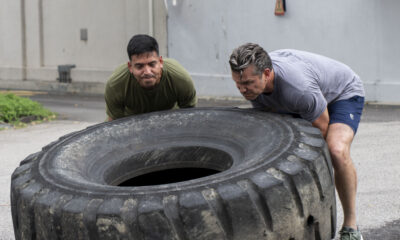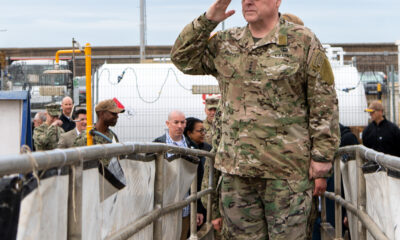Executive
Time To Double Down on Naval Combat Logistics With the Osprey

It is axiomatic that“Soldiers win battles, but logistics wins wars.”
Never in recent memory have combat logistics been more important to the U.S. Navy, whose distributed lethality doctrine calls for widely dispersed forces. Yet, there aren’t enough of the aircraft that makes it work – the CMV-22B Osprey.
Logistics and Distributed Lethality
Today, the U.S. Navy operates using a modern doctrine of ‘distributed lethality’ – more ships, with more weapons, more widely dispersed.
With this operating concept permanently in place, the requirement to support an expanding network of deployed and ashore naval forces calls for increasing the numbers of combat logistics forces and modernizing them sooner rather than later. Robust logistics are more than ‘nice to have’ for distributed forces; they’re mandatory.
Threats in the maritime domain and to our now widely dispersed surface combatant missile shooters, amphibious forces and Carrier Strike Groups are increasing. Non-state actors like the Houthis have impacted the operating tempo of these dispersed ships and, in turn, put a spotlight on the criticality of a robust logistics network to support them.
Our ships must be rearmed, refueled and resupplied frequently to maintain high combat readiness. Accordingly, fleet commanders need more flexibility – not less – when it comes to re-supply.
From Greyhound to Osprey
For 50 years, the Navy has relied on the lumbering C-2 Greyhound for the Carrier Onboard Delivery (COD) mission. The Greyhound, a fixed-wing aircraft at the end of its useful life, can land only in daylight on aircraft carriers and 6,000-foot protected runways ashore.
The Greyhound has served the Navy well for decades, but it is clearly unsuited for the challenges of today’s maritime warfighting domain.
That’s why, building on more than 750,000 flight hours and proven capability to support remote forces, the Navy opted in 2015 to replace the Greyhound with the CMV-22B Osprey, with the potential for a greatly expanded mission set. Today, there are 48 of the aircraft in the Navy’s Program of Record.
Time to Open the Throttle
Unfortunately, the Navy has adopted a cautious, “go-slow” approach to the CMV-22B, with expansion of CMV-22B tiltrotor mission sets taking longer than expected.
The CMV-22B tiltrotor is a capable aircraft whose reliability and availability matches that of virtually all “new-technology” aircraft introduced to the fleet. New machines and operating capabilities come at a price. Integrating new aircraft, fresh operating techniques, and newly trained pilots and crew for the fleet takes time.
Things break, parts wear out, early program delays are expected. Welcome to Naval Aviation, where the pace is fast, work is hard, and the mission is always critical.
But let’s be clear. Tiltrotor technology isn’t exactly new. DoD has already fielded nearly 450 tiltrotor aircraft.
As the lead service, the Marines bought more than 350 MV-22 Ospreys. They were first to employ them in combat, and they used them with great effect in the harsh environments of Iraq and Afghanistan.
Likewise, the U.S. Air Force skillfully employs 50 CV-22s, with their attendant unique flight capabilities for demanding special operations missions. There’s a reason why this one-of-a-kind aircraft type was chosen for such important missions.
The Osprey is the Future of Combat Logistics
Now, the fleet of U.S. Navy CMV-22Bs offers the long-sought promise of expanded versatility, speed, range, payload and landing capabilities.
At sea, in addition to aircraft carriers, the CMV-22B can land on large amphibious ships – without catapults and arresting gear. Ashore, the Osprey can land and take off from unsecure, unimproved landing zones.
The CMV-22B can fly farther, be refueled in flight and even refuel other aircraft ashore, at night, in any weather, ‘off the grid’ – nearly anywhere on the globe.
The CMV-22B can resupply urgently needed parts, including the crucial F-35 “Hot Section,” carried internally. And it can deliver critical materiel, combat troops, and conduct medevacs in a combat environment to and from almost anywhere.
For search and rescue, the Osprey can cover vast ocean environments, such as in the Indo-Pacific theater, with its speed and range. The Air Force routinely conducts hoist operations, so using the CMV-22B in a Search and Rescue (SAR) role is not out of the question.
Above much else, modern warfare requires healthy doses of innovation and flexibility. The Navy’s CMV-22B provides both.
As the linchpin of future Naval logistics, the CMV-22B Osprey offers much needed versatility that fleet commanders desperately need to support forces that are spread out geographically. They are the perfect aircraft to support our modern, distributed, forward-deployed forces.
The Case for More
Because the nature of supporting those forces has changed, we need more of these versatile tiltrotors, and soon.
Current Osprey numbers are simply too low, spreading our combat logistics capability precariously thin, especially in opposed, distributed combat scenarios, forcing fleet commanders to forgo critical resupply and degrading our combat capability.
The Navy has taken delivery of over half of the eventual fleet. However, in my estimation, in a near-peer conflict where logistics are contested, the U.S. Navy will need as many as 70 CMV-22Bs.
When it comes to operationalizing and procuring the Osprey, now is not the time to press “pause” on combat logistics.
This article was originally published by RealClearDefense and made available via RealClearWire.
Sandy Clark is a retired Navy Captain and Naval Aviator whose experience includes a wide variety of domestic and overseas military operations.
-

 Civilization4 days ago
Civilization4 days agoTrump’s Venezuela Gamble and America’s Shifting National Security Strategy
-

 Civilization4 days ago
Civilization4 days agoOperation Absolute Resolve: Anatomy of a Modern Decapitation Strike
-

 Civilization4 days ago
Civilization4 days agoTen Reasons To Cheer the Arrest of Maduro
-

 Civilization2 days ago
Civilization2 days agoOne Fell Swoop: Lawsuit Eyes Death Blow to Racial Preferences
-

 Civilization17 hours ago
Civilization17 hours agoTrump’s New Doctrine of Precision Deterrence
-

 Executive2 days ago
Executive2 days agoWaste of the Day: $1.6T in Wasteful Spending in Rand Paul’s “Festivus” Report
-

 Civilization4 days ago
Civilization4 days agoTrump’s New Executive Order on Space Has the Right Stuff
-

 Guest Columns3 days ago
Guest Columns3 days agoAdvice to Democrats Regarding Maduro Arrest: Resist Reflexive Opposition













